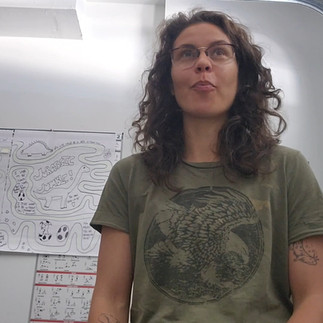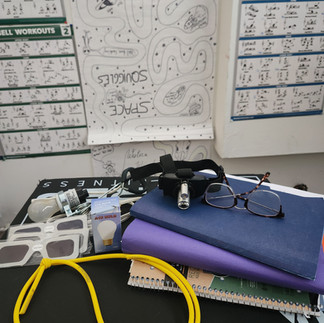My One-Woman PT Superstar: Navigating Healing with a Brain Injury and Post-Concussive Syndrome Symptoms
- jordanswellness

- Oct 20, 2024
- 9 min read
Updated: Feb 19
When I first began my recovery from a brain injury, I felt lost and overwhelmed by the myriad of symptoms I was experiencing. Thankfully, a dear friend of mine, who was in Doctor of Physical Therapy (DPT) school at the time, came to my rescue. During her clinicals, she met an incredible physical therapist who specialized in treating injuries like mine. After hearing about her expertise and compassionate approach, I knew I had to give her a try. Since starting my sessions in April 2024, this one-woman powerhouse has become an essential part of my healing journey. With her targeted techniques and unwavering support, I've begun to navigate the complexities of a brain injury with renewed hope and strength.

Disclaimer: The content shared on this blog is based on my personal experiences and should not be considered medical advice. I am not a healthcare professional, and the information provided is intended for informational purposes only. Always consult with a qualified healthcare provider before making decisions related to your health, treatments, or therapy. Results and experiences may vary from person to person, and I cannot guarantee specific outcomes.
Since April 2024, I’ve been fortunate to work with an incredible physical therapist who has become my guiding star in navigating the complexities of my recovery from a brain injury and post-concussive syndrome (PCS) symptoms. Each week, we tackle a range of issues that stem from my brain injury, including neck instability, jaw alignment (which luckily was an easy fix), and eye tracking difficulties among just a few to list. Her expertise has been invaluable, and I can’t wait to share how her targeted approach is helping me heal.

1. C1/C2 Adjustments
One of the first things we focused on was adjusting my cervical spine, particularly the C1 and C2 vertebrae. These adjustments are crucial for restoring alignment and alleviating pain that can radiate from the neck to the head. Proper alignment reduces pressure on the brainstem, which is vital for overall neurological function. By correcting these misalignments, I’ve experienced a significant reduction in headaches and improved overall stability.
As my symptoms improve, I anticipate needing fewer adjustments over time. The C1 and C2 vertebrae can easily become misaligned due to various factors, including poor posture, stress, or trauma from a head injury. To help prevent misalignment in the future, it’s essential to incorporate practices like maintaining good posture, engaging in regular neck-strengthening exercises, and being mindful of ergonomics in daily activities. Stretching and mobility work can also support the stability of the upper cervical spine, promoting long-term health and reducing the need for frequent adjustments.
2. Jaw Alignment
In this image gallery, we capture a journey of transformation.
The first photo showcases my smile before the brain injury—bright, vibrant, and straight. This image reflects a time of confidence and health, where my teeth were white and my smile radiated joy.
In the center photo, there’s a stark contrast. My teeth appear dull and misaligned, and the smile that once felt natural now carries the weight of my struggles. This visual representation highlights the impact of my brain injury, affecting not just my physical health but my overall sense of well-being.
The final photo shows me actively working on my jaw exercises in physical therapy. Here, I’m taking steps toward reclaiming my smile and addressing the misalignment that has resulted from my injury. This image signifies hope and determination as I focus on healing and rebuilding my jaw strength, proving that recovery is a journey worth smiling about.
In my ongoing journey of recovery, I recently came across a fascinating publication that explores the connection between brain injuries and dental care. It’s eye-opening to realize how intricately linked our dental health is to overall neurological function.
Research indicates that after a brain injury, muscle tension and misalignment can affect not only the jaw but also the surrounding structures, potentially leading to issues like temporomandibular joint (TMJ) dysfunction. This can cause pain, discomfort, and even exacerbate cognitive symptoms, making dental care an essential component of recovery. Additionally, there can be issues with blood flow and circulation which can issues with saliva production, gum health, and cavities.
I plan to delve deeper into this connection in an upcoming blog entry, where I’ll share insights and findings that underscore the importance of integrating dental health into brain injury recovery plans. For now, it's crucial to acknowledge that maintaining oral health can significantly impact overall healing and well-being after a brain injury. Stay tuned for more details!
Check out the article:
During this journey, I noticed something unexpected: my jaw appeared misaligned in a photo I took with my husband while smiling. This observation prompted me to dig deeper into potential issues related to my brain injury.
Jaw alignment is often overlooked in concussion recovery, but it plays a critical role in overall head and neck health. My PT incorporates manual techniques and exercises to help realign my jaw, which can relieve tension and pain that might otherwise exacerbate my symptoms. This alignment not only helps with comfort but also improves my ability to chew and speak without discomfort.

3. Neck Instability
Given the trauma my neck has endured, addressing neck instability is essential. We work on strengthening the muscles that support my cervical spine through a variety of exercises. These include gentle resistance training and stability drills that help reinforce the surrounding musculature, ensuring my neck can properly support my head.
One of the key tools we use is a noodle tension band, which wraps around my head. This allows me to perform resistance exercises that promote stability and strength. For example, I perform controlled head turns against the tension, which helps engage the muscles in my neck while improving range of motion.
We also incorporate chin tucks, where I gently draw my chin towards my chest while keeping my shoulders relaxed. This exercise not only strengthens the deep neck flexors but also helps correct posture, which is vital for reducing strain on my cervical spine.
Another effective drill involves rocking my head forward and back, which enhances proprioception—the awareness of my body’s position in space. This is particularly beneficial for combating the dizziness and disorientation often associated with post-concussive syndrome (PCS).
Finally, I perform exercises where I look in the opposite direction of the tension in the band. This not only strengthens the back of my neck but also enhances the connection between my eyes and neck, fostering better coordination and balance.
Overall, these exercises are designed to build resilience in my neck, reduce instability, and alleviate the dizziness and disorientation that often accompany PCS. By focusing on strengthening and stabilizing the muscles that support my cervical spine, I’m taking significant steps toward improving my overall recovery.
4. Eye Tracking
Another critical area of focus has been eye tracking. My PT employs specific exercises that require me to hold picture cards in each hand, positioned about arm’s length away and shoulder-width apart. These cards feature different shapes, and I must move my head from one card to the other while calling out the shapes in order or identifying the color of each shape. This exercise not only helps with coordination but also reinforces visual processing skills, which have been impacted by my brain injury.
Additionally, I work on rapidly moving a card in one hand in front of my face while trying to call out the number, shape, or color of the card in the other hand. This particular exercise is the hardest for me, as it challenges my ability to quickly process visual information while coordinating my head movements. By consistently practicing these eye tracking exercises, I am gradually improving my blurry vision and double vision, which are common symptoms of post-concussion syndrome (PCS). The benefits extend beyond just vision, helping to enhance my overall cognitive function and reducing the disorientation that often accompanies these visual difficulties.
5. Eye and Neck Connection with a Laser
Using a laser, my therapist helps illustrate the connection between my eye movements and neck positioning. This innovative approach helps me better understand how my visual system interacts with my neck, which is crucial for coordination and balance. By making this connection, I can work on exercises that enhance both systems simultaneously.
Balancing on the Wooden Board: In this image, my lower body and feet are poised on a wooden balance board, showcasing my focus and determination as I work on improving my stability and coordination. The board's surface is slightly elevated, adding an extra challenge to my balance training, which is crucial for my recovery from post-concussion syndrome (PCS).
The Laser Maze: This image captures the impressive graphic of the laser maze displayed on the wall. The maze features intricate paths and vibrant colors, inviting me to trace the lines with a laser that is projected from the device on my head. This exercise is designed to enhance my visual tracking and spatial awareness while providing a fun and engaging way to work on my rehabilitation.
Upper Body View with Laser: In the final image, I’m seen from the upper body perspective, with the laser positioned on my head. I’m in the process of moving my neck to follow the maze across the room. This exercise requires coordination and concentration as I aim to align the laser with the paths on the wall, further challenging my eye and neck connection. It’s a vital part of my therapy that helps improve my overall movement and cognitive processing.
6. Balance
Balance training has been a game-changer in my recovery. My therapist incorporates various drills, such as standing on one leg or using balance boards, to challenge my stability and coordination. These exercises are essential for rebuilding the vestibular system's function, which often suffers after a concussion. Improved balance not only reduces my risk of falls but also enhances my overall confidence in daily activities.

7. Upper Back and Neck Strengthening
To support my neck and alleviate tension, we focus on strengthening my upper back and neck. Exercises include rows, neck retractions, and shoulder blade squeezes, all designed to promote proper posture and reduce the strain on my neck. Strengthening these areas is vital for combatting symptoms of PCS, as a strong upper body provides the foundation needed for proper head and neck alignment.
Working with my one-woman PT superstar has been a transformative experience. Her personalized approach and deep understanding of post-concussive syndrome have made all the difference in my recovery journey. Each session brings new insights and progress, empowering me to reclaim my health and navigate the complexities of my symptoms. Now, there are still days that a one-hour session wipes me out for days (literally 72-hours), but I know that it is helping rebuild for my future self.
If you’re dealing with PCS symptoms from a brain injury or any related challenges, I encourage you to seek out a skilled physical therapist who can tailor a program to your unique needs. With the right support, healing is not just a possibility; it’s an achievable goal.
All my light. All my love.
Namaste.
Jordan
My Gear:






























Comments